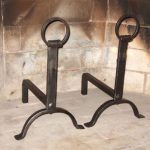 Andirons are metal supports that sit on the floor of a fireplace and hold the logs in place so that they tumble neither forward nor backward while they burn; at one time, pairs of andirons were also used to support a spit, so that meat could be roasted above the fire. Although andirons have always been made of iron, the word andiron actually has nothing to do with the word iron: instead, andiron derives ultimately from andero, a Gaulish word meaning young bull, so called because the top ends of these iron supports were often moulded to look like a bull’s head (just as the name claw-foot was bestowed on furniture legs moulded to resemble a lion’s paw). This Gaulish word, andero, became the Old French andier, which English adopted as aundyre in the fourteenth century; shortly after, however, people began to assume that the iron the device was made of was also the source of its name, and accordingly they mistakenly changed the spelling to andiron. Other people went further in trying to “improve” the spelling of the word, sometimes spelling it hand-iron and sometimes even giving it the name of another cooking utensil, the brandiron, a griddle whose name really does derive from iron. In the sixteenth century, andirons also acquired a completely new name, fire-dogs, so named, no doubt, because they were no longer decorated with the head of a bull, but of a dog, the guardian of the hearth and home.
Andirons are metal supports that sit on the floor of a fireplace and hold the logs in place so that they tumble neither forward nor backward while they burn; at one time, pairs of andirons were also used to support a spit, so that meat could be roasted above the fire. Although andirons have always been made of iron, the word andiron actually has nothing to do with the word iron: instead, andiron derives ultimately from andero, a Gaulish word meaning young bull, so called because the top ends of these iron supports were often moulded to look like a bull’s head (just as the name claw-foot was bestowed on furniture legs moulded to resemble a lion’s paw). This Gaulish word, andero, became the Old French andier, which English adopted as aundyre in the fourteenth century; shortly after, however, people began to assume that the iron the device was made of was also the source of its name, and accordingly they mistakenly changed the spelling to andiron. Other people went further in trying to “improve” the spelling of the word, sometimes spelling it hand-iron and sometimes even giving it the name of another cooking utensil, the brandiron, a griddle whose name really does derive from iron. In the sixteenth century, andirons also acquired a completely new name, fire-dogs, so named, no doubt, because they were no longer decorated with the head of a bull, but of a dog, the guardian of the hearth and home.
